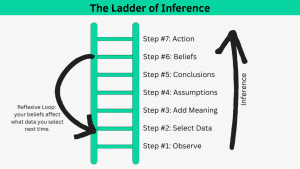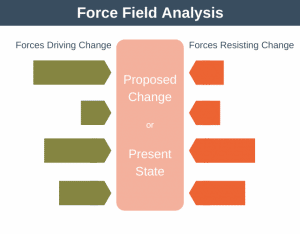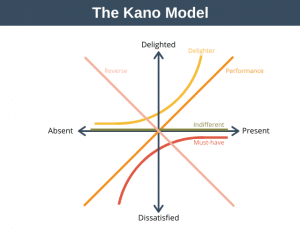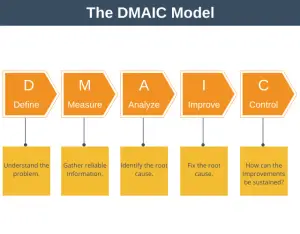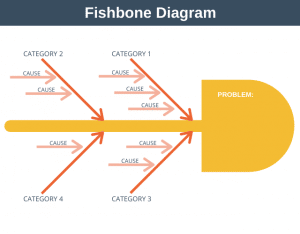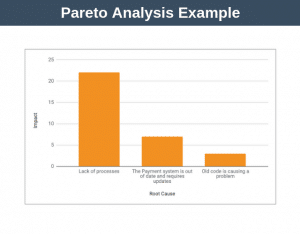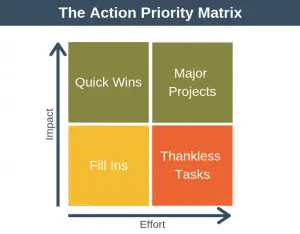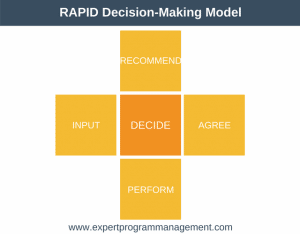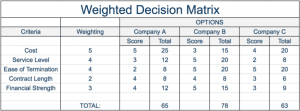The elaboration likelihood model (ELM) is a theory of persuasion or attitude change that proposes that people can be persuaded in one of two ways.
What does elaboration mean in the context of the model? You can think of elaboration as referring to how much conscious thought you put into making a decision. If you elaborate on something, then it means you are really thinking about it.
If you’re highly interested in a topic and have the ability to think about your decision, then you will be likely to elaborate on your decision. In this case, persuasion will occur using what the model calls central route processing. You will examine and weigh up the information carefully before making your decision.
Conversely, if the decision is less important to you or you have little time available to think about it, you won’t invest much or any time elaborating on your decision. In this case, persuasion will occur using what the model calls peripheral route processing. You’ll be influenced by associating the decision with positive or negative cues or by using cognitive cues.
Background
The elaboration likelihood model was developed by Richard E. Petty and John Cacioppo in 1980. They noticed that previous persuasion theories gave conflicting results and developed the model to explain better how people are persuaded. They did this by proposing two routes of persuasion that the results of previous studies can fall into.
Elaboration Likelihood Model
The diagram below outlines the elaboration likelihood model.
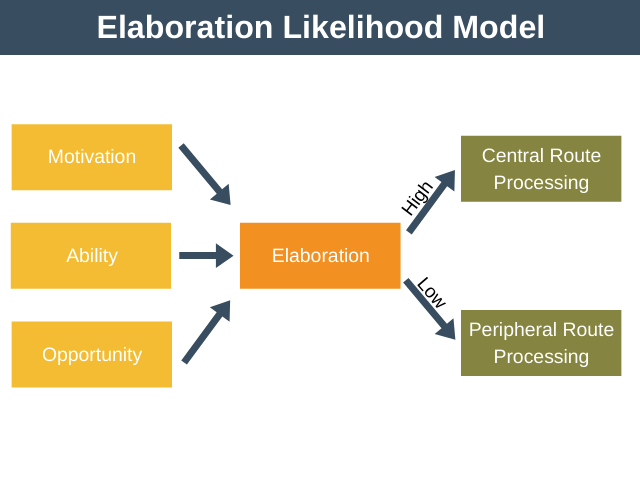
As you can see, if elaboration is high, then you will process the decision through your central route. If elaboration is low, you’ll process the decision through your peripheral route.
Likelihood of Elaboration
To determine which route to use, the model says that three factors determine whether your elaboration is likely to be high. These are:
1. Motivation
If you have a high desire to process the message you’re receiving, then your motivation will be high.
For example, imagine the government announced new tax reliefs for recently married couples. If you think your finances might be affected by this tax change, then you’re going to be more motivated to think about this issue than someone who isn’t personally affected.
2. Ability
Even if we want to elaborate, it can be difficult if we don’t have the ability. This can happen when, for example, you’re in a noisy environment, or when you don’t have enough knowledge about a subject to be able to think deeply about it.
3. Opportunity
Having the opportunity means you have the time available to receive the message, process it, and then make your decision.
Routes
1. Central Route Processing
Central route processing happens when elaboration is higher. Using central route processing, you’ll listen carefully to the message and evaluate the pros and cons before making your decision.
Central route processing requires your conscious thought and critical thinking. To be able to process in this way, you must be motivated, have the ability, and the opportunity.
Through central route processing, you can form attitudes and even beliefs. Views formed through central route processing tend to be long-lasting. When you create an attitude or view in this way, you’re less likely to change your mind about it later and more likely to behave in ways that match your new position.
2. Peripheral Route Processing
When one or more of motivation, ability, or opportunity is missing or low, then you’re more likely to process information via the peripheral route.
Using the peripheral route you’re not consciously examining information, and you’ll often make your decision based on:
- Positive or negative cues you’ve picked up.
- Rules of thumb.
- What you’ve seen others do.
In essence, you’re trying to decide without investing any real thinking time.
Peripheral route processing is essential because you simply don’t have time to consider every decision you make carefully. By making the minor decisions on auto-pilot using peripheral processing, you free up more time to think about the more significant decisions you need to make.
Because you haven’t invested any real effort into the decision making processes, you don’t cling to attitudes formed using this route as strongly as you would if the central route had created those attitudes.
Note that the two routes are not binary options, we can use both at the same time. Sometimes we might mostly use central route processing with a little bit of peripheral route processing. Sometimes we might mostly use Peripheral route processing with a little bit of central route processing. Both exist on a sliding scale.
Elaboration Likelihood Model Example
Imagine that you are a marketing executive tasked with selling a new brand of shampoo.
You decide to use the elaboration likelihood model to develop a marketing campaign that uses both the central and peripheral processing routes.
First, you decide to create an ad targeting central route processors. People who are considering a shampoo via the central route might be particularly conscious of their image or whether there are any artificial ingredients contained within the shampoo. To appeal to these people, you decide to create a set of ads and online landing pages highlighting both the unique formula of the shampoo, which makes your hair appear shiny, and its all-natural ingredients.
To target the peripheral processors, you do something different. You work with celebrities and social media influencers to create a set of ads and social media, showing these people enjoying and being satisfied with the product. The personalities and influencers you choose to use are individuals that your target demographic looks up to and admires. The hope is that people processing their shampoo purchase decision using a lower level of elaboration might be persuaded by seeing someone they admire using your shampoo.
Advantages and Disadvantages
There are several pros and cons associated with the elaboration likelihood model.
Advantages
- The model gives you a framework by which you can assess how best to persuade someone.
- It is possible to use both the central route and peripheral route persuasion at the same time.
Disadvantages
- The model doesn’t state when to use a particular form of persuasion, merely that the best model to use will be dependent on the elaboration level of the message recipient.
- More of a criticism than a disadvantage, but the model is based on the assumption that attitudes formed through central route processing will be stronger and harder to alter.
- When wishing to persuade a low elaborator, there is no indication of what’s the best way to do this. Going back to our shampoo example, seeing your favorite celebrity might nudge you towards buying, but perhaps if you dislike the music in the ad it might nudge you away from buying.
Summary
The elaboration likelihood model is a theory of persuasion that explains that you can motivate people via one of two processing routes.
When elaboration is higher, people use central route processing requiring conscious cognition. Conversely, when elaboration is lower, people use peripheral route processing where they are influenced by rules of thumb and what they have observed others doing.
